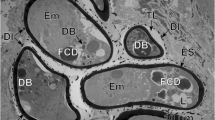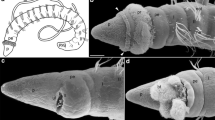Summary
An ultrastructural study of the tube foot wall of a regular echinoid,Diadema antillarum, was made. Ciliated microvillous epithelial cells, their inclusions, amoebocytes, and the arrangement of collagen and muscle in the tube feet are described. The neuropile, together with its vesicular components and possible neurosecretory elements, is considered and discussed as are connective tissue bridges across the lumen. Consideration is given to possible functions for the various components of the tube foot.
Similar content being viewed by others
References
Bacetti, B.: High resolutions on collagen of Echinodermata. Monitors zool. ital. (N.S.)1, 201–206 (1967).
Bargmann, W.,M. v.Harnack u.K. Jacob: Über den Feinbau des Nervensystems des Seesternes (Asterias rubens L.). I. Mitt. Ein Beitrag zur Vergleichenden Morphologie der Glia. Z. Zellforsch.56, 573–594 (1962).
—, u.Br. Behrens: Über den Feinbau des Nervensystems des Seesternes (Asterias rubens L.) II. Mitt. Zur Frage des Baues und der Innervation der Ampullen. Z. Zellforsch.59, 746–770 (1963).
Bern, H.: On the production of hormones by neurones and the role of neurosecretion in neuroendocrine mechanisms. Symp. Soc. exp. Biol.20, 325–344 (1966).
Cobb, J. L. S.: The fine structure of the pedicellariae ofEchinus esculentus (L.). I. The innervation of the muscles. J. roy. micr. Soc.88, 211–221 (1968a).
—: The fine structure of the pedicellariae ofEchinus esculentus (L.). II. The sensory system. J. roy. micr. Soc.88, 223–233 (1968b).
—, andM. S. Laverack: The lantern ofEchinus esculentus (L.). II. Fine structure of hyponeural tissue and its connexions. Proc. roy. Soc. B164, 641–650 (1966).
Coleman, R.: Ultrastructure of the tube foot sucker of a regular echinoid,Diadema antillarum Philippi, with especial reference to secretory cells. Z. Zellforsch.96, 151–161 (1969).
Fawcett, D. W.: An atlas of fine structure. The cell, its organelles and inclusions. Philadelphia: W. B. Saunders & Co. 1966.
Haggis, G. H.: In: The electron microscope in molecular biology, p. 21. London: Longmans 1966.
Kawaguti, S.: Electron microscopic structures of the podial wall of an echinoid with special references to the nerve plexus and the muscle. Biol. J. Okayama Univ.10, 1–12 (1964).
Nichols, D.: A comparative histological study of the tube feet of two regular echinoids. Quart. J. micr. Sci.102, 157–180 (1961).
—: In: Echinoderms. London: Hutchinson 1962.
—: Echinoderms: experimental and ecological. Oceanogr. mar. biol. Ann. Rev.2, 393–423 (1964).
Pequignat, E.: “Skin digestion” and epidermal absorption in irregular and regular urchins and their probable relation to the outflow of spherule-coelomocytes. Nature (Lond.)210, 397–399 (1966).
Reynolds, E. S.: The use of lead citrate at high pH as an electron-opaque stain in electron microscopy. J. Cell Biol.17, 208–212 (1963).
Scharrer, B.: The role of neurosecretion in neuroendocrine integration. In: Comparative endocrinology (ed.A. Gorbman), p. 134–148. New York: Wiley 1959.
Smith, J. E.: The structure and function of the tube feet in certain echinoderms. J. mar. biol. Ass.22, 345–357 (1937).
—: The motor nervous system of the starfish,Astropecten irregularis (Pennant) with special reference to the innervation of the tube feet and ampullae. Phil. Trans. B234, 521–558 (1950).
—: The form and function of the nervous system. In: Physiology of Echinodermata (ed.R. A. Boolootian). New York: Interscience, Wiley 1966.
Watson, M. L.: Staining of tissue sections for electron microscopy with heavy metals. J. biophys. biochem. Cytol.4, 475–478 (1958).
Author information
Authors and Affiliations
Additional information
I am indebted to ProfessorN. Millott for his help and encouragement during the course of this work, to Mr.Raynor L. Jones for his expert technical assistance, and to Dr.H. G. Vevers and the Zoological Society of London.
Rights and permissions
About this article
Cite this article
Coleman, R. Ultrastructure of the tube foot wall of a regular echinoid,Diadema antillarum Philippi. Z. Zellforsch. 96, 162–172 (1969). https://doi.org/10.1007/BF00338764
Received:
Issue Date:
DOI: https://doi.org/10.1007/BF00338764




